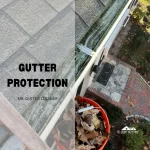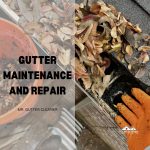Winter months bring the looming threat of ice dams, a common yet preventable issue affecting many homes.
Ice dams occur when melted snow refreezes at the roof’s edge, preventing proper drainage through gutters.
This blockage can lead to significant water damage within the home structure.
Effective gutter maintenance is crucial in preventing these ice formations.
Regular cleaning, coupled with proper attic insulation and ventilation, significantly reduces the risk.
Additionally, understanding the timing and frequency of maintenance, as well as when to employ professional help, can further protect your home.
This article discusses comprehensive strategies to prevent ice dams, ensuring the longevity and safety of your home during the colder months. By adhering to these guidelines, homeowners can maintain a robust defense against the costly and destructive effects of ice dams.
Understanding Ice Dams
Ice dams are ridges of ice that form at the edge of a roof and prevent melting snow from draining off the roof. They can result in costly damage to your home, making it crucial to understand their formation and prevention.
What Are Ice Dams and How Do They Form?
Ice dams develop when the roof over the attic gets warm enough to melt the underside of the layer of snow on the roof. The water trickles down between the layer of snow and the shingles until it reaches the eave of the roof, which stays cold because it extends beyond the side of the house. There, the water freezes, gradually growing into a mound of ice. The key factors contributing to the formation include heavy snowfall, fluctuations in outdoor temperatures, and heat loss from the house due to inadequate roof or attic insulation.
Why Are Ice Dams a Concern for Homeowners?
Ice dams can cause significant damage to your home. As ice accumulates, it can back up under roof shingles, damaging them and leading to leaks. The water that leaks into your home can ruin insulation, ceilings, walls, and floors. Moreover, the weight of the ice itself can damage gutters and pose a risk of injury from falling icicles. Understanding these impacts emphasizes the importance of preventive measures in home maintenance to avoid costly repairs and maintain structural integrity.
The Role of Gutters in Ice Dam Formation
Proper gutter maintenance is essential in mitigating ice dam formation. Gutters play a critical role in directing melting snow and water away from your home’s structure. When gutters are clogged or malfunctioning, water can back up and freeze, contributing to the formation of ice dams.
How Do Gutters Contribute to Ice Dam Build-Up?
Gutters contribute to ice dam build-up when they are blocked with debris, such as leaves and twigs, preventing water from flowing freely. This blockage can cause water to overflow and freeze at the edges, exacerbating the ice dam problem. Furthermore, poorly insulated or improperly installed gutters can expedite ice formation due to thermal inefficiency, allowing snow to melt and refreeze at the roof’s edge.
The Importance of Gutter Health in Winter Months
Maintaining gutter health is paramount in winter months to prevent ice dams. Regular cleaning and inspection ensure that water is efficiently channeled away from your home, reducing the risk of ice dam formation. Additionally, installing gutter guards can prevent debris accumulation, while proper insulation and heating cables can maintain an even temperature, further mitigating the risk. Homeowners should prioritize gutter maintenance as part of their overall home maintenance to protect against the pervasive and costly damage caused by ice dams.
Preventative Measures for Ice Dams
Adopting preventative measures is key to mitigating the risk of ice dams and ensuring the longevity and safety of your home during winter. Regular gutter maintenance, coupled with other home care strategies, forms a robust defense against ice dam formation.
Regular Gutter Maintenance: A Key Strategy
Regular gutter maintenance is critical in preventing ice dams. Ensuring that gutters and downspouts are clear of leaves, twigs, and other debris allows melting snow to flow freely, reducing the likelihood of ice accumulation. Homeowners should inspect and clean gutters at least twice a year: once in late spring and again in early fall. However, in areas prone to heavy snowfall, additional inspections may be necessary.
Best Practices for Gutter Cleaning
Effective gutter cleaning involves removing debris, flushing the gutters with water, inspecting for any damage, and ensuring that downspouts are clear and well-directed away from the house foundation. Utilizing tools like gutter scoops, garden hoses, or even specialized gutter cleaning services can make the process more efficient and thorough.
Timing and Frequency of Gutter Maintenance
The timing and frequency of gutter maintenance can vary based on several factors including tree coverage, the type of gutter system installed, and local weather patterns. Generally, it’s recommended to clean gutters in late spring after trees have shed their blossoms and seeds, and early fall after leaves have dropped. However, for homes surrounded by pine trees or those in regions with frequent storms, more frequent cleaning might be necessary.
Additional Home Maintenance Tips to Prevent Ice Dams
Beyond gutter maintenance, several additional measures can be taken to prevent ice dams:
Proper Attic Insulation and Ventilation
Improving attic insulation and ventilation prevents heat from escaping to the roof, thereby reducing snow melt. The attic temperature should be close to the outside temperature to minimize the risk of snow melting and refreezing at the roof’s edge.
The Use of Roof Rakes and De-Icing Cables
After heavy snowfall, using a roof rake to remove snow from the edges of your roof can prevent ice dams from forming. Additionally, installing de-icing cables along the roof’s edge and within gutters can provide targeted heat to prevent ice accumulation.
Identifying and Addressing Existing Ice Dams
Once ice dams form, it’s crucial to address them promptly to prevent extensive damage. Identifying and safely removing these ice formations, while understanding when to seek professional help, are vital components of home maintenance during winter.
How to Safely Remove Ice Dams from Your Roof
Removing ice dams can be a delicate process. The safest approach involves using a roof rake to gently remove snow from the roof’s edge without damaging the shingles. For ice, applying calcium chloride ice melt can help break it down. However, physical removal should be done cautiously to avoid damaging the roofing materials or causing injury. Never use sharp tools or excessive force, and avoid working on icy roofs due to the risk of falls.
When to Call a Professional for Ice Dam Removal
Professional removal is often the safest option, especially for significant ice dam issues. Professionals have the necessary equipment and expertise to safely and effectively remove ice dams without damaging the roof. If you’re unsure about the safety of removing an ice dam yourself, or if the dam is extensive, calling in a certified professional is the recommended course of action. They can also provide insights into long-term prevention strategies specific to your home’s needs.
Long-Term Solutions and Upgrades
To effectively combat ice dams and reduce their occurrence, homeowners should consider long-term solutions and upgrades that increase efficiency and safety, reducing the need for frequent maintenance and emergency measures.
Gutter Guards and Heat Tape: Are They Worth It?
Installing gutter guards can prevent debris from clogging the gutters, ensuring that water flows freely and reducing the chances of ice dam formation. These guards come in various styles and materials, each with its benefits and considerations. Similarly, heat tape, also known as heat cables, can be installed along gutters and downspouts to maintain a consistent temperature, preventing ice buildup. While both gutter guards and heat tape represent an upfront investment, they can provide significant long-term benefits by preventing ice dams, reducing maintenance needs, and extending the lifespan of your gutter system.
Evaluating Your Home’s Heat Loss
A key factor in preventing ice dams is minimizing heat loss from your home. Conducting an energy audit can identify areas of heat loss, particularly in the attic or roof area. Proper insulation and ventilation in these areas can significantly reduce the amount of heat reaching the roof, thus preventing the melting and refreezing cycle that leads to ice dam formation. Upgrading insulation, sealing leaks, and improving ventilation are all effective strategies in reducing heat loss and are essential components of a long-term approach to preventing ice dams. By investing in these home upgrades, homeowners not only prevent ice dams but also enhance the overall energy efficiency and comfort of their home.
Understanding the Financial and Safety Implications
The financial and safety implications of ice dams are significant, impacting both immediate expenses and long-term home value. Understanding these aspects can motivate homeowners to adopt preventative measures and consider the broader implications of home maintenance.
The Cost of Neglecting Gutter Maintenance
Neglecting gutter maintenance can lead to severe financial consequences. The initial costs may seem minimal, but the long-term expenses associated with repairing damage caused by ice dams can be substantial. These costs include roof repairs, interior damage restoration, and increased energy bills due to heat loss. Proactive gutter maintenance is a cost-effective strategy compared to the potential expenses of ice dam-related damages.
Ice Dams and Home Insurance: What’s Covered?
It’s vital to understand what your home insurance covers in terms of ice dam damage. While some policies may cover damages, there are often specific requirements or limitations. Generally, insurance may cover the repair of the actual damage caused by the ice dam, but not the removal of the ice dam itself. Homeowners should review their policies and consider additional coverage if necessary. Understanding insurance coverage can provide peace of mind and inform decisions about preventative maintenance and emergency measures.
FAQs About Ice Dams and Gutter Maintenance
This section addresses frequently asked questions about ice dams and gutter maintenance, providing clear, concise, and informative answers to the common concerns homeowners have regarding this winter issue and how it affects their home maintenance routines.
Can Ice Dams Cause Permanent Damage to My Home?
Yes, ice dams can cause permanent damage if not addressed promptly. The weight of the ice can strain gutters and roof structures, while the water that backs up behind the dam can leak into your home, damaging walls, ceilings, insulation, and other internal structures. This moisture can also lead to mold and mildew problems, which pose health risks and further damage to the home.
How Often Should I Inspect My Gutters in Winter?
You should inspect your gutters at least twice a year, in the late spring and early fall. However, in winter, especially in areas prone to heavy snowfall and ice formation, it’s wise to inspect them more frequently. After every major storm or significant snowfall, check your gutters for ice dam formation, icicles, and blockages to ensure they are functioning correctly. Regular inspection helps in early detection and prevention of potential ice dams.


